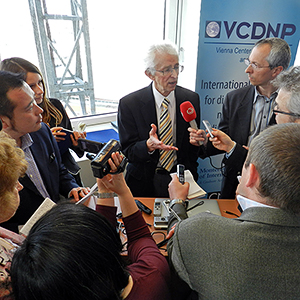

On 18 April 2013, Dr. Siegfried Hecker, VCDNP Distinguished Visiting Fellow (on sabbatical from Stanford University), delivered a presentation on recent developments in North Korea’s nuclear program. His assessment of North Korea’s technical capabilities, based on seven visits to North Korea between 2004 and 2010, showed that Pyongyang does not have the ability to carry out the escalating threats it has issued since the UN Security Council resolution condemning its third nuclear test on 12 February 2013.
In March 2013, the Democratic People’s Republic of Korea (DPRK)’s Plenary of Central Committee declared that the country will move forward with both nuclear power construction and enhancement of its nuclear armed forces. On 2 April 2013, the General Department of Atomic Energy announced the “readjustment” and restarting of all nuclear facilities at Yongbyon. Pyongyang continued to escalate its threats in April 2013 when it moved road-mobile intermediate-range missiles to its east coast, apparently in preparation for flight-testing.
Dr. Hecker stated that these recent developments demonstrate Pyongyang’s intention to pursue both plutonium and highly enriched uranium (HEU) nuclear weapon programs, which is also consistent with Pyongyang’s announcement that it will increase both the quantity and sophistication of its nuclear arsenal. Dr. Hecker estimates that North Korea has only 24 to 42 kilogram of plutonium, sufficient for four to eight nuclear weapons. Pyongyang intends to increase its plutonium inventory by restarting the Yongbyon plutonium production reactor. However, that will not constitute an immediate threat, Dr. Hecker stated, because it will take roughly three years to harvest more plutonium. It will take about six months to restart the reactor, followed by two years of reactor operation, along with cooling time and reprocessing time. After that, North Korea will be capable of producing about 6 kg, or one bomb’s worth, of plutonium on the average per year.

Dr. Hecker interprets the Pyongyang announcement of “readjusting” some Yongbyon facilities to likely mean that it will convert the uranium centrifuge facility it showed to Dr. Hecker and colleagues in 2010 from making more reactor fuel for its experimental light-water reactor under construction to producing HEU for bombs. The enrichment plant at Yongbyon, if properly configured, is estimated to be able to produce around 40 kg of HEU, sufficient for one to two HEU bombs, per year. Dr. Hecker believes that North Korea has a covert enrichment facility, although its capacity is likely limited. However, no one knows for certain. Therefore, he emphasized the importance of limiting DPRK’s access to the equipment and materials for their enrichment program through tight import and export controls.
Dr. Hecker believes that, at present, North Korea does not have intercontinental ballistic missiles that can reach the United States, nor do they have reliable intermediate-range, road mobile missiles capable of hitting Japan, both of which are still many years away from being operational. North Korea would require more nuclear tests to miniaturize nuclear warheads and more missile tests. Regarding the shorter-range missiles (up to 1,000 km), the situation is not so clear. Hecker believes that North Korea would still need at least one more nuclear test to miniaturize warheads for any of its missiles and it will require a robust missile-testing program with mock-up warheads. At the moment, therefore, according to Dr. Hecker, “most of the things they threatened to do, they cannot do.” However, there are serious concerns in the event of possible miscalculation or instability, particularly because of the inexperience of the country’s young leader. This threat will become greater if more bombs and better missiles are produced.

Dr. Hecker discussed a number of potential solutions to deal with the situation in North Korea. He emphasized the concern regarding possible nuclear exports from the DPRK, which may include materials, technology, and know-how. North Korea exported uranium hexafluoride to Libya and built a plutonium-production reactor for Syria. Pyongyang has exported missile technologies to various states and today’s greatest concerns are nuclear export or cooperation with Iran. Dr. Hecker said that the exports “are big money makers for DPRK and pose a serious threat; therefore they are very difficult to stop.” Further on, he suggested the need to “deal with DPRK as it is and not the way we would like it to be.” So, in the short term, he said it is important not to let matters get worse. He proposed “three No’s:” no more bombs, no better bombs—which he said means no nuclear tests—and no exports. In the longer term, it is essential to achieve denuclearization, but to do so one needs to address the fundamentals of the DPRK’s insecurity and create conditions favorable to its disarmament. In order to stop the further production of bombs, the import to DPRK of materials and equipment necessary for highly enriched uranium production must be prevented. In this context, China plays a very important role in stopping the supply and implementing tight export controls.
At the end of the seminar, Dr. Hecker took questions from journalists. See a recentinterview with Dr. Hecker by the Bulletin of Atomic Scientists.
Several news outlets reported about Dr. Hecker’s seminar at the VCDNP, including:
